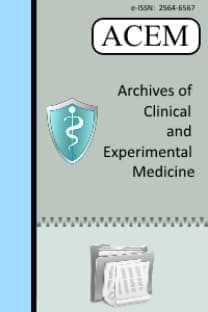Görüntüleme kılavuzluğunda perkütan nefrostomi: 6 yıllık tek merkez deneyimi
Perkütan nefrostomi, üriner sistem obstrüksiyonu, üriner sistem kaçağı, üriner fistül, girişimsel radyoloji
Radiologically guided percutaneous nephrostomy: A 6-year single-center experience
Percutaneous nephrostomy, urinary system obstruction, urinary leakage, urinary fistula, interventional radiology,
___
- 1. Dagli M, Ramchandani P. Percutaneous nephrostomy: technical aspects and indications. Semin Interv Radiol. 2011;28:424–37.
- 2. Pabon-Ramos WM, Dariushnia SR, Walker TG, d’Othée BJ, Ganguli S, Midia M, et al. Quality improvement guidelines for percutaneous nephrostomy. J Vasc Interv Radiol. 2016;27:410–4.
- 3. Ramchandani P, Cardella JF, Grassi CJ, Roberts A.C, Sacks D, Schwartzberg M.S, et al. Quality improvement guidelines for percutaneous nephrostomy. J Vasc Interv Radiol. 2003;14:277–81.
- 4. Young M, Leslie SW. Percutaneous Nephrostomy. [Updated 2019 Jun 17]. In: StatPearls [Internet]. Treasure Island (FL): StatPearls Publishing; 2019 Jan-. Available from: https://www.ncbi.nlm.nih.gov/books/NBK493205/
- 5. Efesoy O, Saylam B, Bozlu M, Çayan S, Akbay E. The results of ultrasound-guided percutaneous nephrostomy tube place¬ment for obstructive uropathy: A single-centre 10-year experience. Turk J Urol 2018; 44: 329-34.
- 6. Lodh B, Gupta S, Singh AK, Sinam RS. Ultrasound guided direct percutaneous nephrostomy (pcn) tube placement: stepwise report of a new technique with its safety and efficacy evaluation. J Clin Diagn Res 2014;8:84-7.
- 7. Montvilas P, Solvig J, Johansen TE. Single-centre review of radiologically guided percutaneous nephrostomy using “mixed” technique: success and complication rates. Eur J Radiol. 2011;80:553–8.
- 8. Farrell TA, Hicks ME. A review of radiologically guided percutaneous nephrostomies in 303 patients. J Vasc Interv Radiol. 1997;8:769–74.
- 9. Radecka E, Magnusson A. Complications associated with percutaneous nephrostomies. A retrospective study. Acta Radiol. 2004;45:184–8.
- 10. Gupta DK, Chandrasekharam VV, Srinivas M, Bajpai M. Percutaneous nephrostomy in children with ureteropelvic junction obstruction and poor renal function. Urology. 2001;57:547–50.
- 11. Hogan M, Coley BD, Jayanthi VR, Shiels WE. Percutaneous Nephrostomy in Children and Adolescents: Outpatient Management. Radiology 200;218:207–10.
- 12. Chitale SV, Scott-Barrett S, Ho ET, Burgess NA. The management of ureteric obstruction secondary to malignant pelvic disease. Clin Radiol. 2002;57:1118–21.
- 13. Meira MDS, Barbosa PNVP, Bitencourt AGV, Almeida MFA, Tyng CJ, Costa MAF et al. Retrospective analysis of computed tomography-guided percutaneous nephrostomies in cancer patients. Radiol Bras. 2019;52:148–54.
- 14. Millward SF. Percutaneous nephrostomy: a practical approach. J Vasc Interv Radiol 2000;11:955-64.
- 15. Patel U, Hussain FF. Percutaneous nephrostomy of nondilated renal collecting systems with fluoroscopic guidance: technique and results. Radiology. 2004;233:226-33.
- 16. Gayer G, Zissin R, Apter S, Garniek A, Ramon J, Kots E, et al. Urinomas caused by ureteral injuries: CT appearance. Abdom Imaging. 2002;27:88–92.
- 17. Avritscher R, Madoff DC, Ramirez PT, Wallace MJ, Ahrar K, Morello FA, et al. Fistulas of the lower urinary tract: percutaneous approaches for the management of a difficult clinical entity. Radiographics, 2004;24:S217–S36.
- 18. Titton RL, Gervais DA, Hahn PF, Harisinghani MG, Arellano RS, Mueller PR. Urine leaks and urinomas: diagnosis and imaging-guided intervention. Radiographics 2003;23:1133–47.
- 19. Hunter DW, Castaneda-Zuniga WR, Coleman CC, Herrera M, Amplatz K. Percutaneous techniques in the management of urological complications in renal transplant patients. Radiology. 1983;148:407-12.
- 20. Gregory MC, Micklos J, Miller FJ, et al. Percutaneous dilatation and stenting of ureteral stenosis in renal transplantation. Clin Trans. 1988;2:107-9c.
- 21. Patel U, Hussain FF. Percutaneous nephrostomy of nondilated renal collecting systems with fluoroscopic guidance: technique and results. Radiology. 2004;233:226-33.
- 22. Ferral H, Stackhouse DJ, Bjarnason H, Hunter DW, Castaneda-Zúñiga WR, et al. Complications of percutaneous nephrostomy tube placement. Semin Intervent Radiol 1994;11:198–206.
- 23. Cochran ST, Barbaric ZL, Lee JJ, Kashfian P. Nephrostomy tube placement: an outpatient procedure? Radiology 1991;179:843–7.
- 24. Moon E, Tam MD, Kikano RN, Karuppasamy K. Prophylactic antibiotic guidelines in modern interventional radiology practice. Semin Intervent Radiol. 2010;27:327–37.
- 25. Smith TP, Hunter DW, Letourneau JG, Cragg AH, Darcy MD, Castaneda-Zuniga WR, et al. Urine leaks after renal transplantation: Value of percutaneaous pyelography and drainage for diagnosis and treatment. AJR Am J Roentgenol. 1988;151:511–3.
- 26. Sim LS, Tan BS, Yip SK, Ng CK, Lo RH, Yeong KY, et al. Single centre review of radiologically-guided percutaneous nephrostomies: a report of 273 procedures. Ann Acad Med Singapore 2002;31:76-80.
- 27. Wah TM, Weston MJ, Irving HC. Percutaneous nephrostomy insertion: outcome data from a prospective multi-operator study at a UK training centre. Clin Radiol. 2004;59:255–61.
- ISSN: 2564-6567
- Yayın Aralığı: Yılda 3 Sayı
- Başlangıç: 2016
- Yayıncı: -
GÜLBEN SAYILAN ÖZGÜN, ERAY ÖZGÜN, KIYMET TABAKÇIOĞLU, SELMA SÜER GÖKMEN, Sevgi ESKİOCAK
Malek BOUHANİ, Olfa JAIDANE, Mohamed Amine BOUIDA, Radhi BENNACEUR, Riadh CHARGUI, Khaled RAHAL
SİBEL ÖZLER, Basak Gumus GULER
Ufuk MEMİŞ, Erdem KARADENİZ, Müfide Nuran AKÇAY, Nurinnisa ÖZTÜRK
Ufuk MEMİŞ, ERDEM KARADENİZ, Müfide Nuran AKÇAY, Nurinnisa ÖZTÜRK
Rabia Bilge ÖZGÜL ÖZDEMİR, Alper Tunga ÖZDEMİR, Cengiz KIRMAZ, Mehmet İbrahim TUĞLU, Özgür ŞENOL, Cenk Serhan ÖZVEREL, Afig BERDELİ
Görüntüleme kılavuzluğunda perkütan nefrostomi: 6 yıllık tek merkez deneyimi
Mehmet ŞEKER, Türkmen Turan ÇİFTÇİ, Devrim AKINCI, Okan AKHAN
Pilonidal sinüs cerrahisinde etkin minimal invaziv bir yöntem: Sinüsotomi
Zeynep DİCLE YILDIZ, Adile Merve BAKİ, Canan BAŞARAN KÜÇÜKGERGİN, Pervin VURAL, Semra Doğru ABBASOĞLU, Müjdat UYSAL
Anorektal malign melanom: Bir olgu sunumu ve tedavi seçenekleri
Hacı Hasan ABUOĞLU, Mehmet GENÇTÜRK, Mehmet Kamil YILDIZ, Onur İLHAN, Mehmet GULMEZ, Kübra KAYTAZ, Selvinaz ÖZKARA
